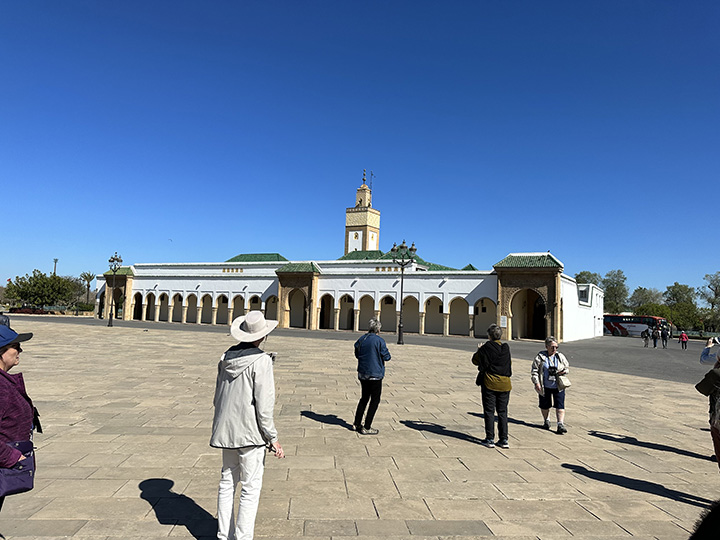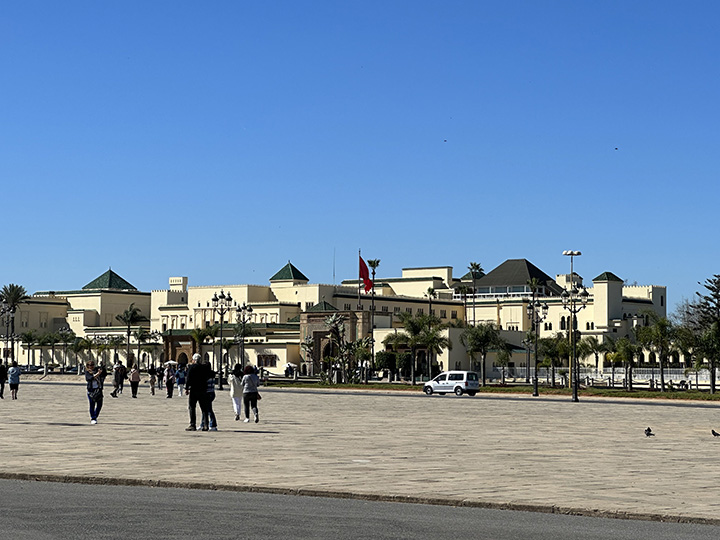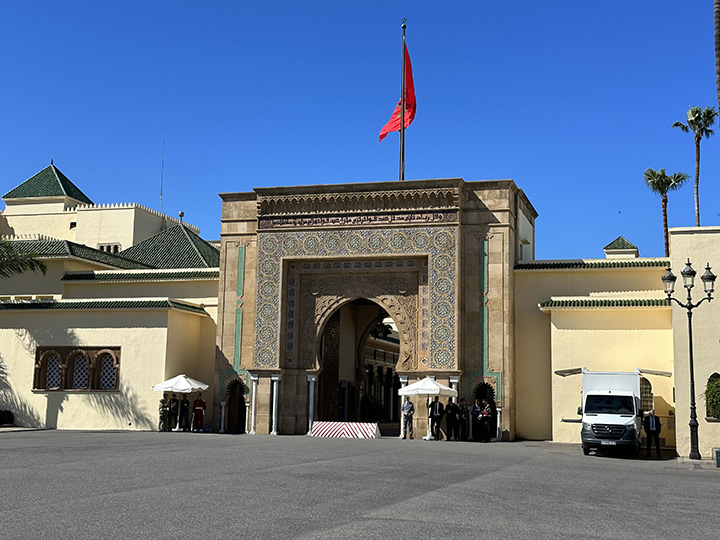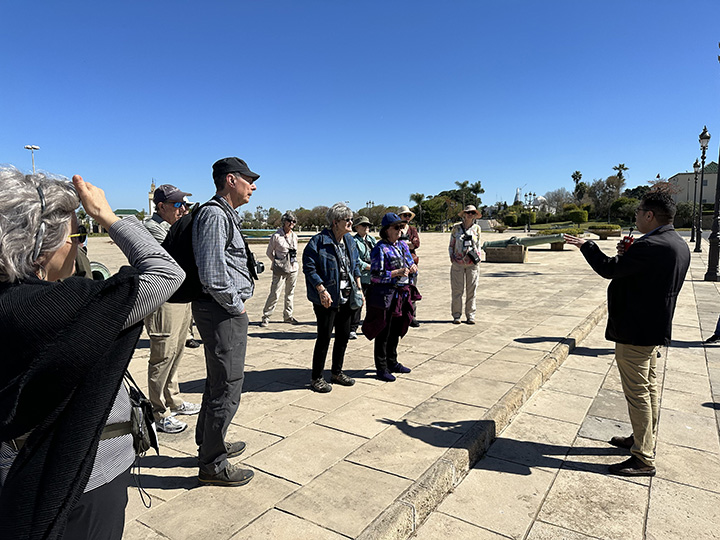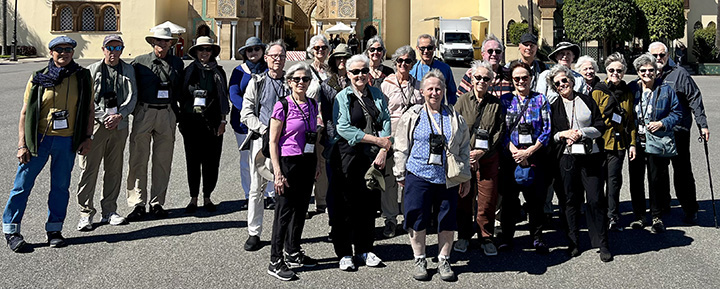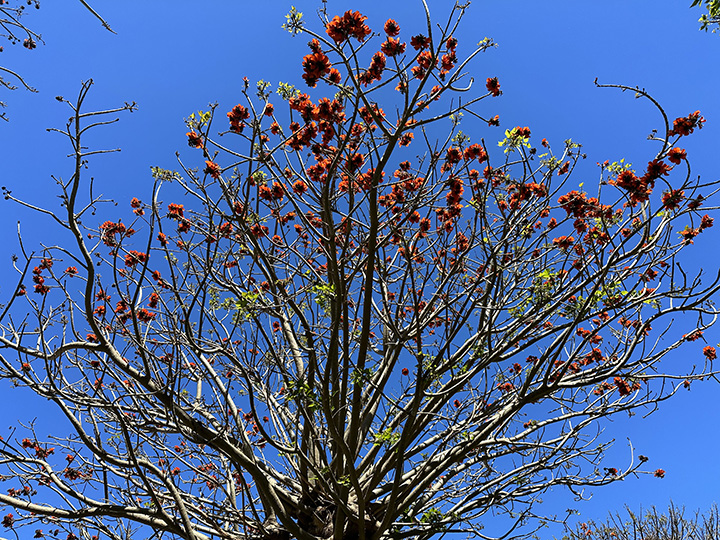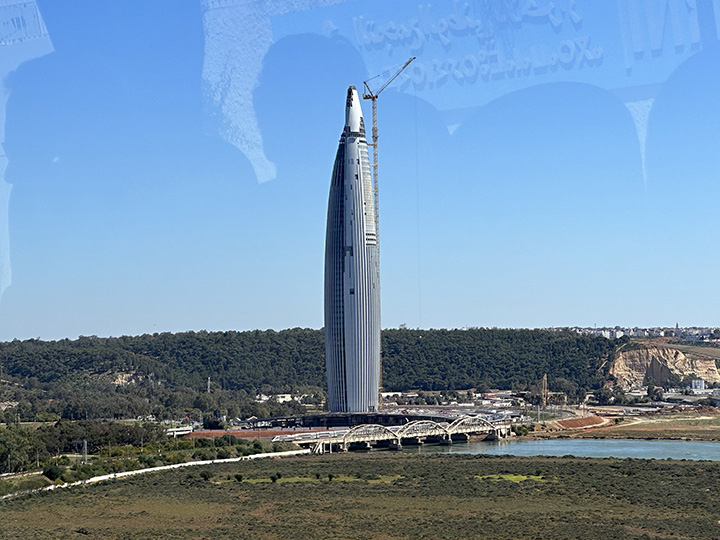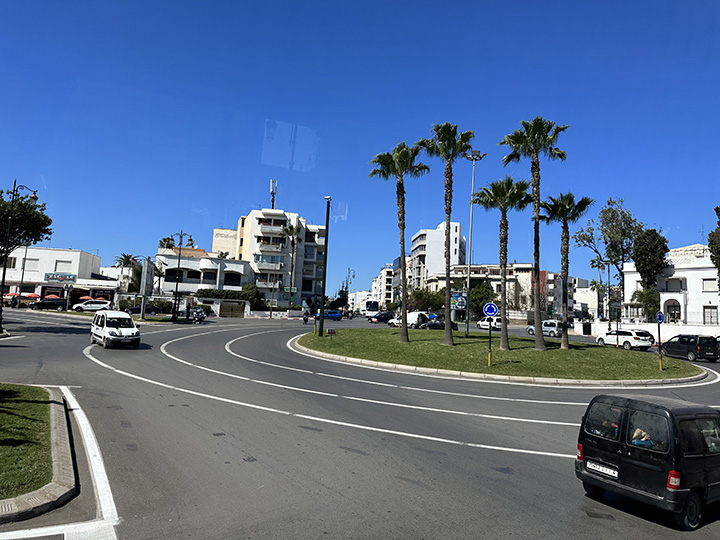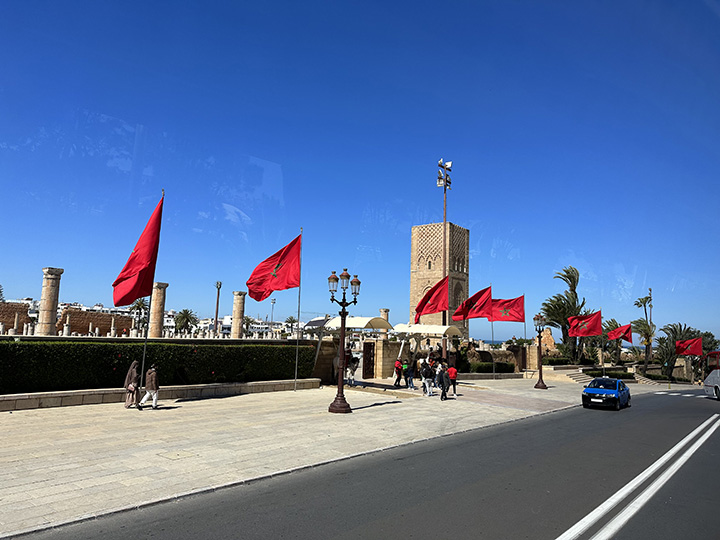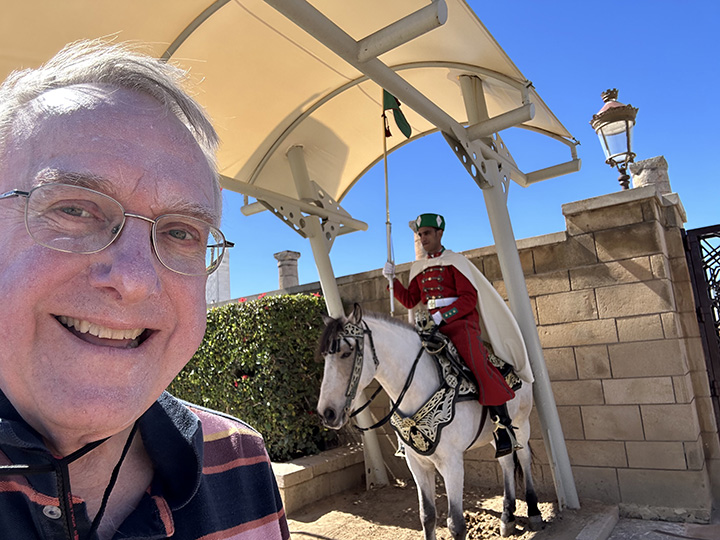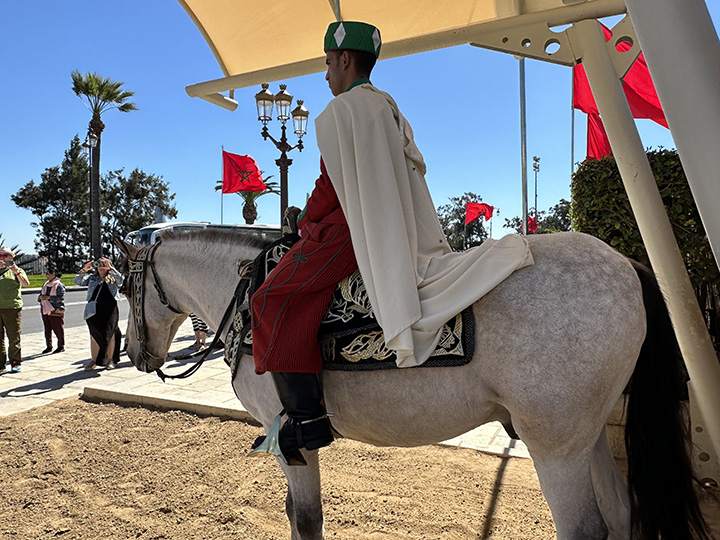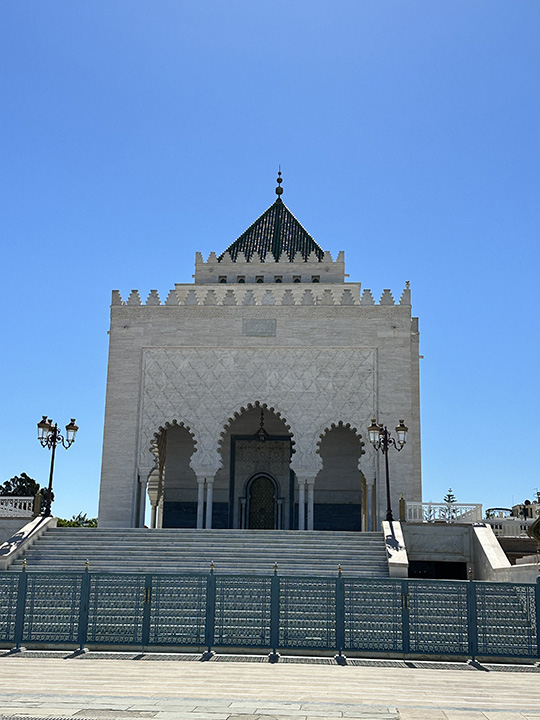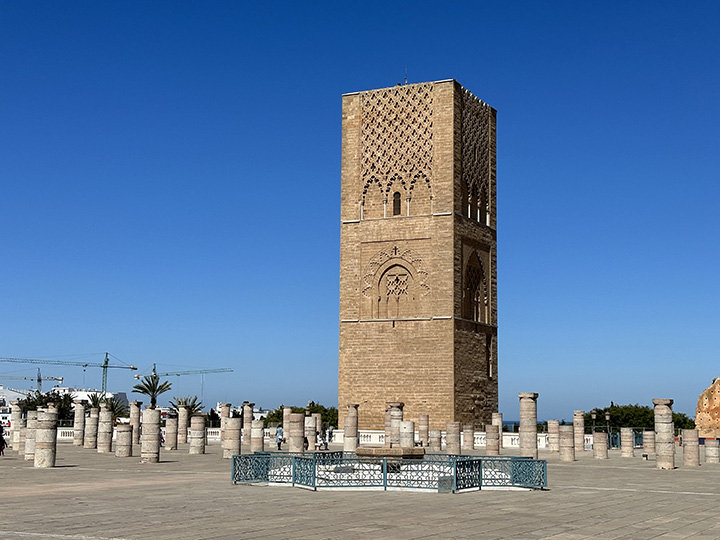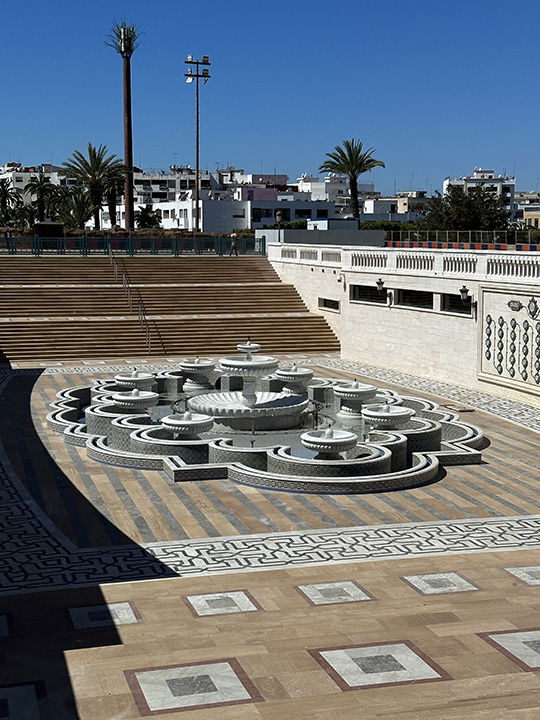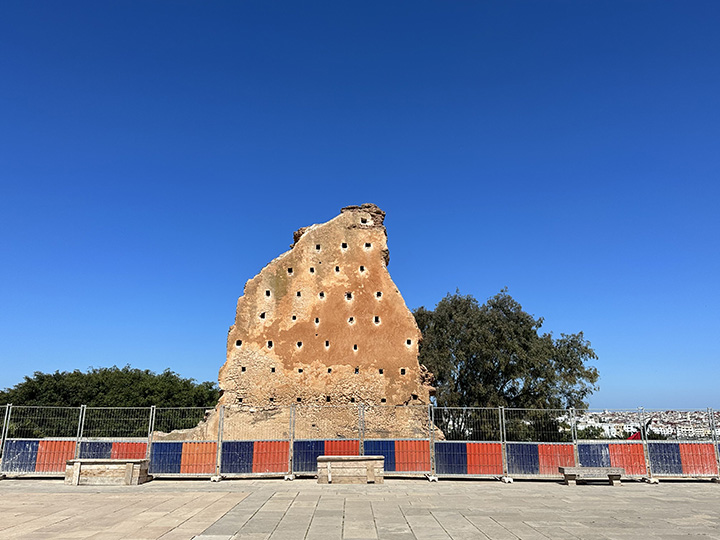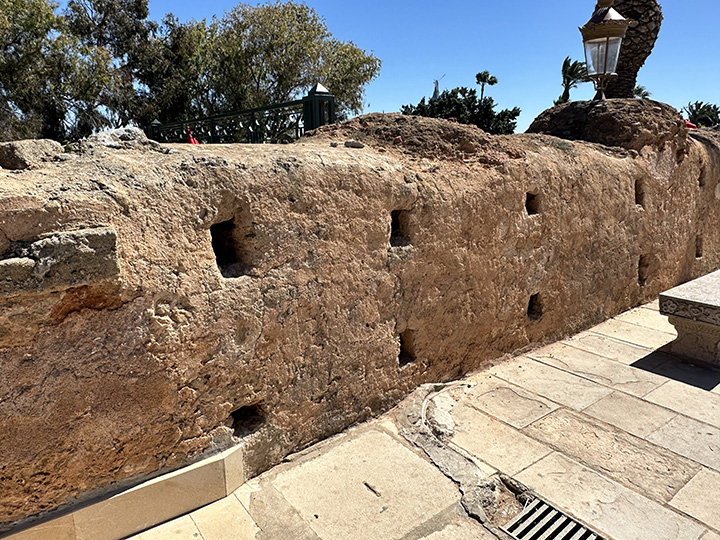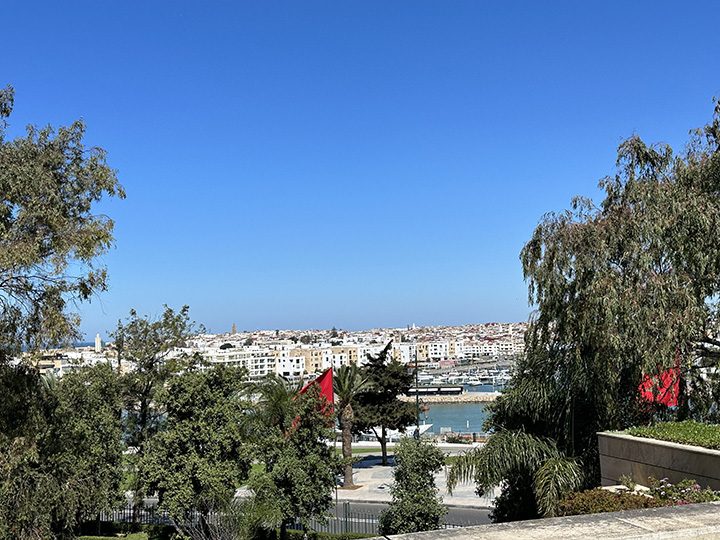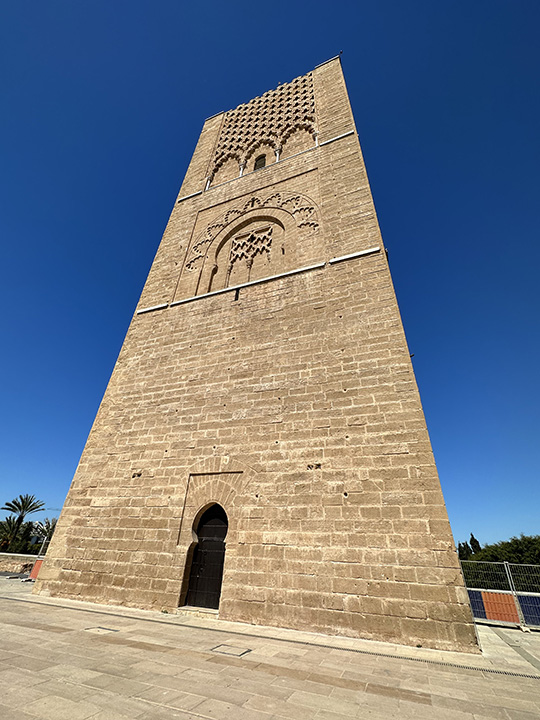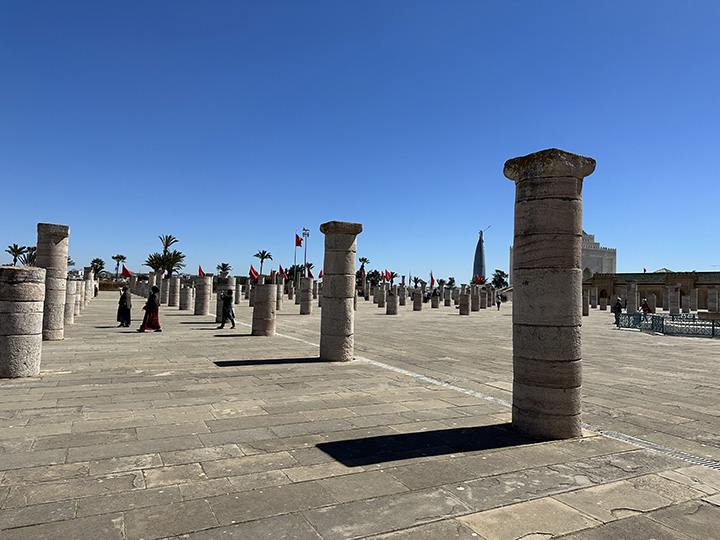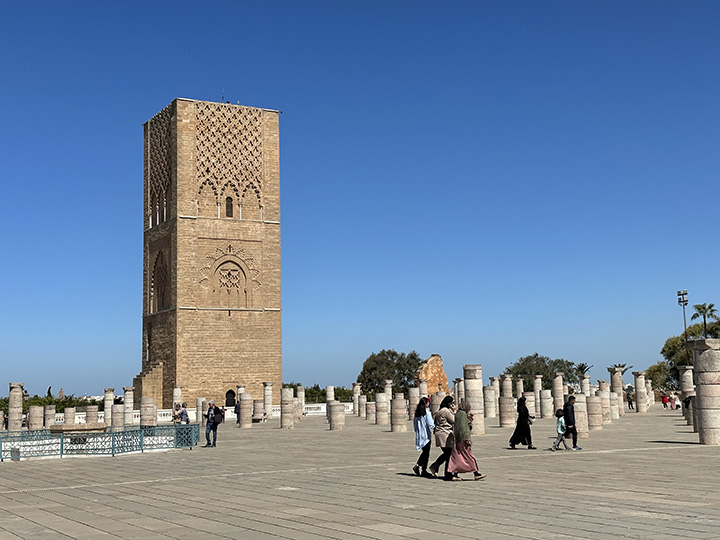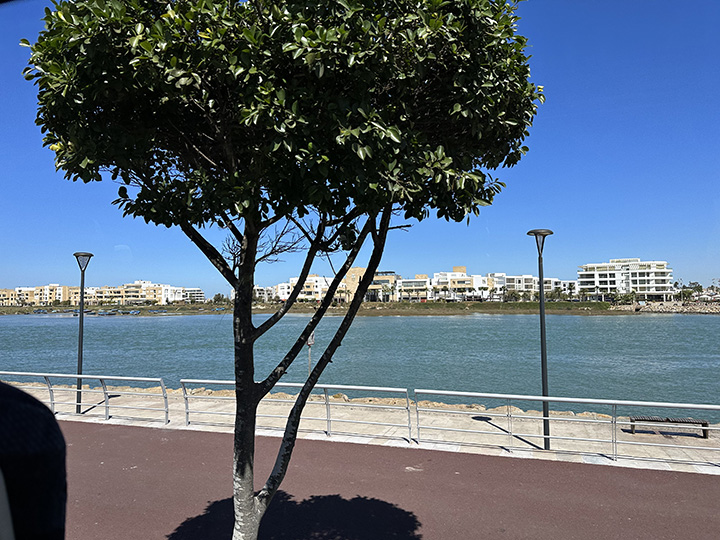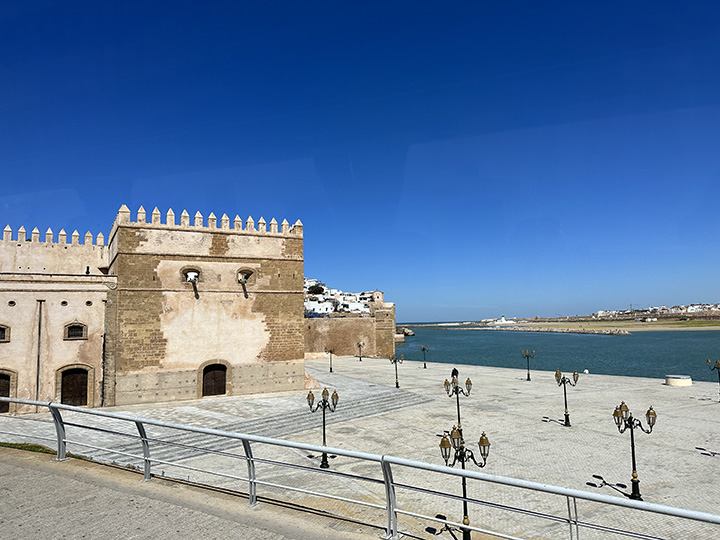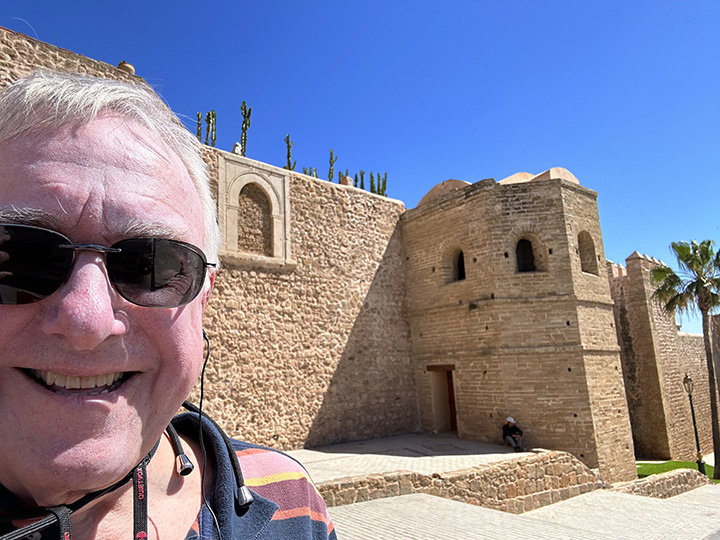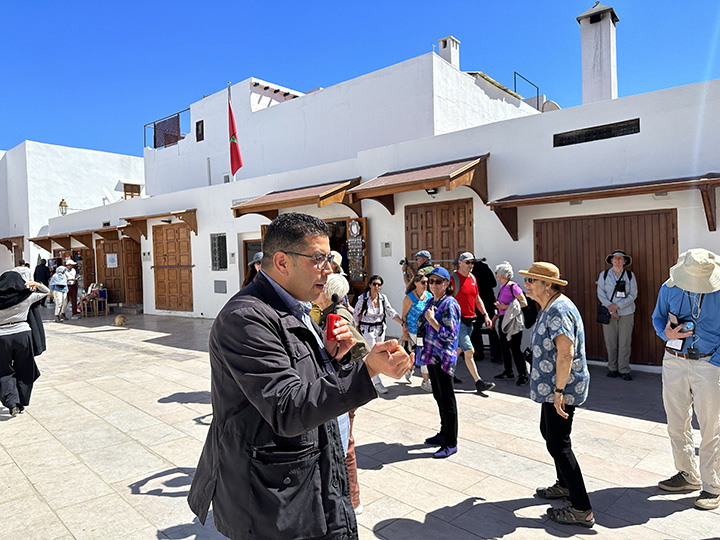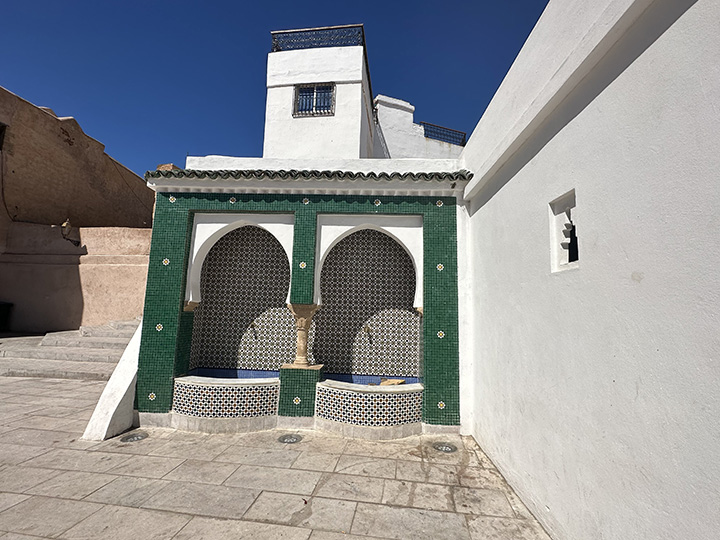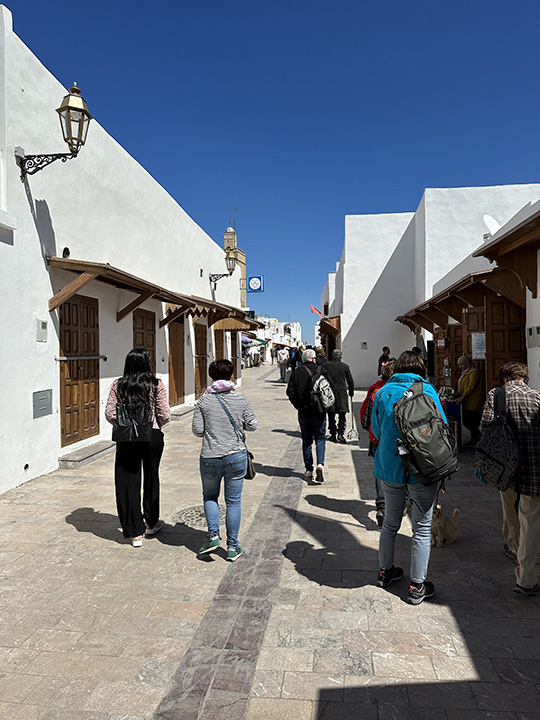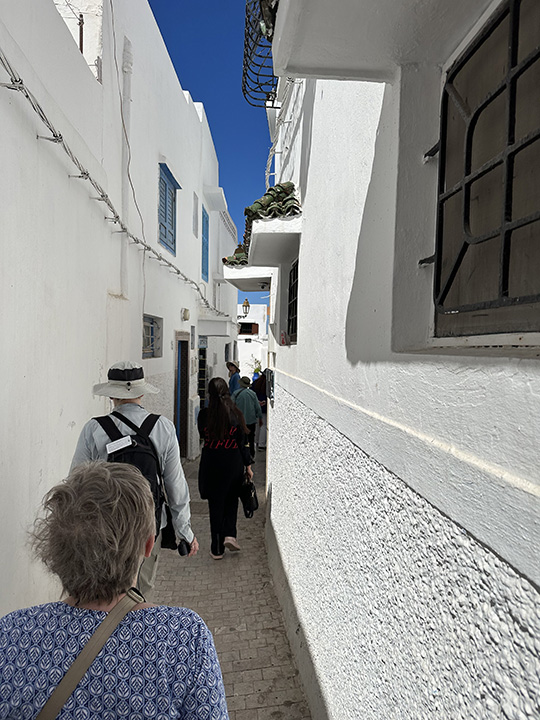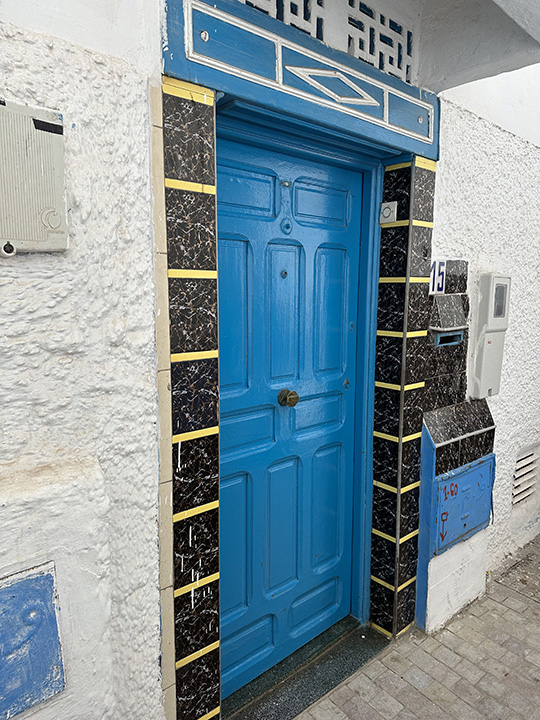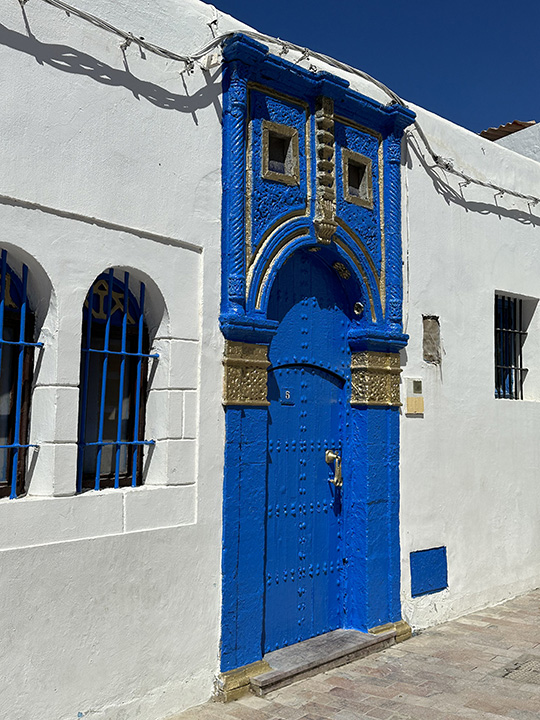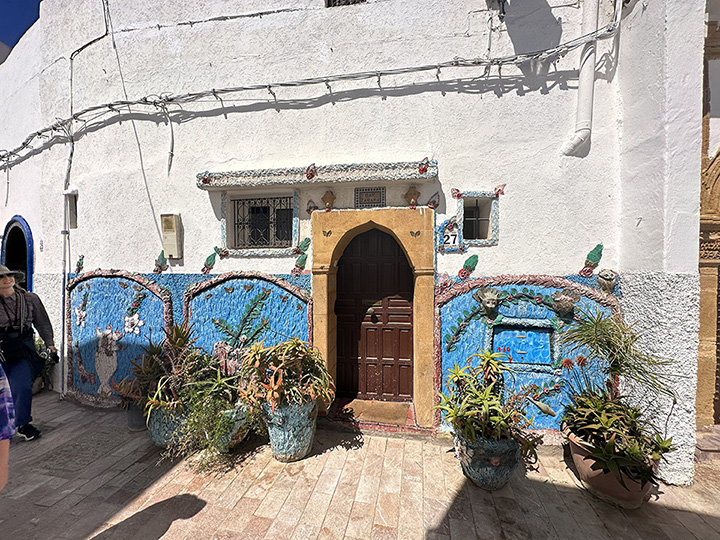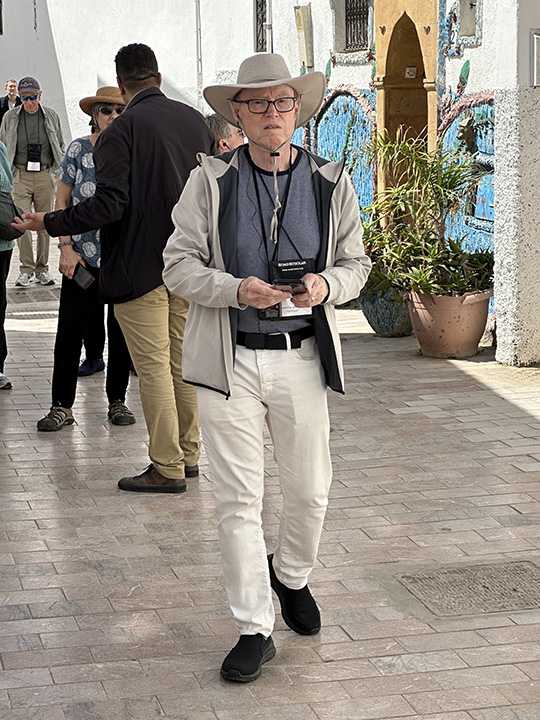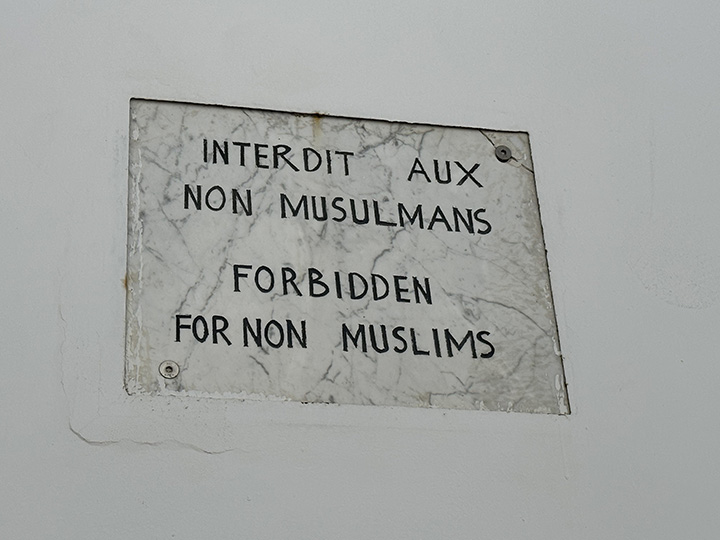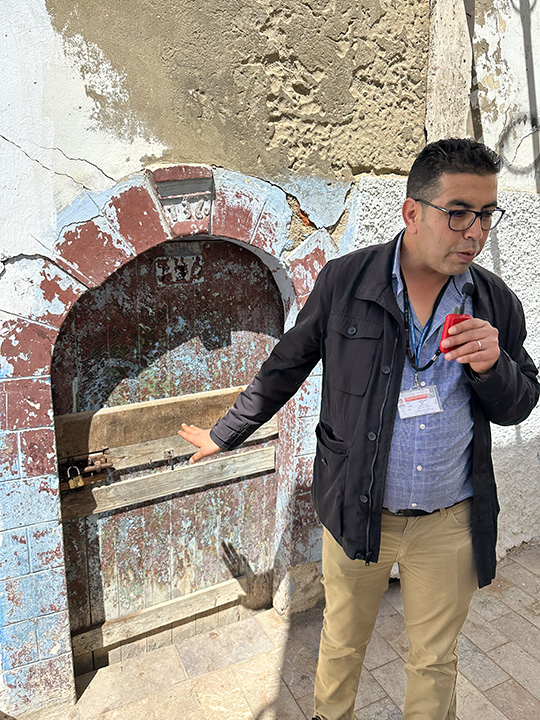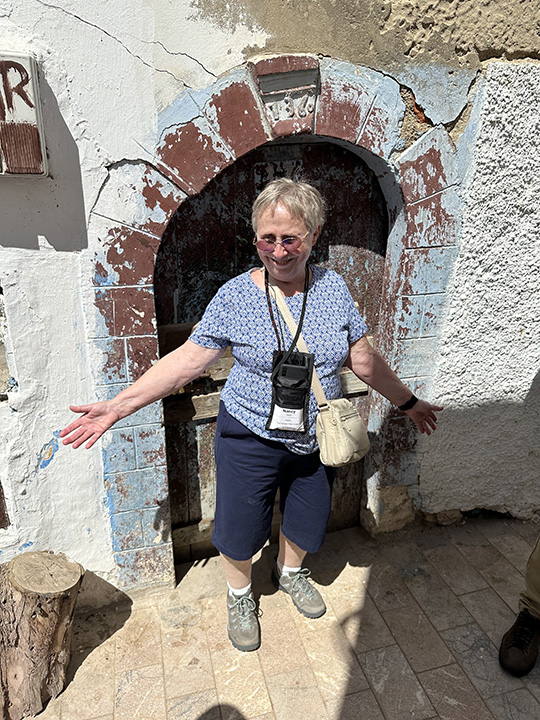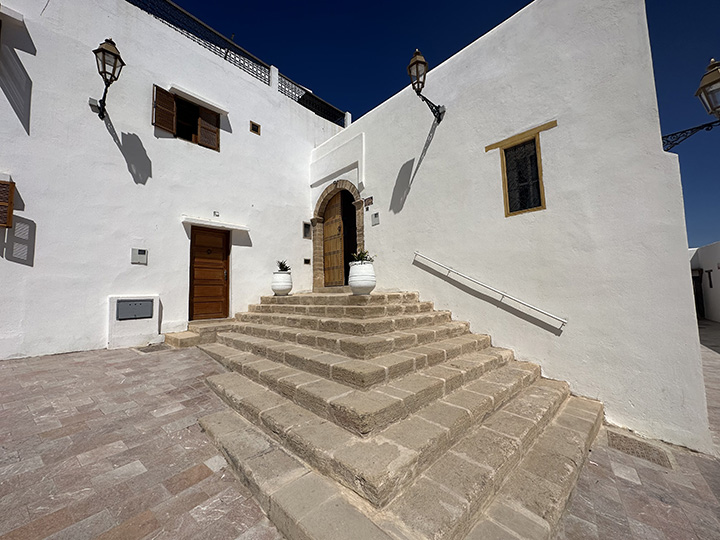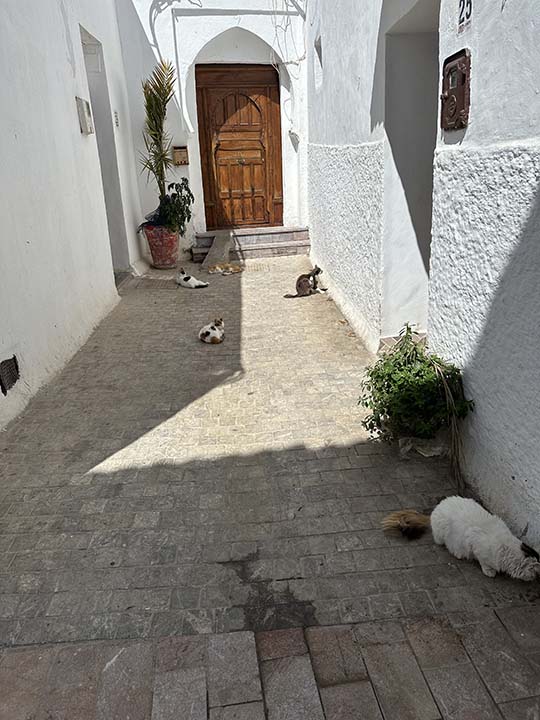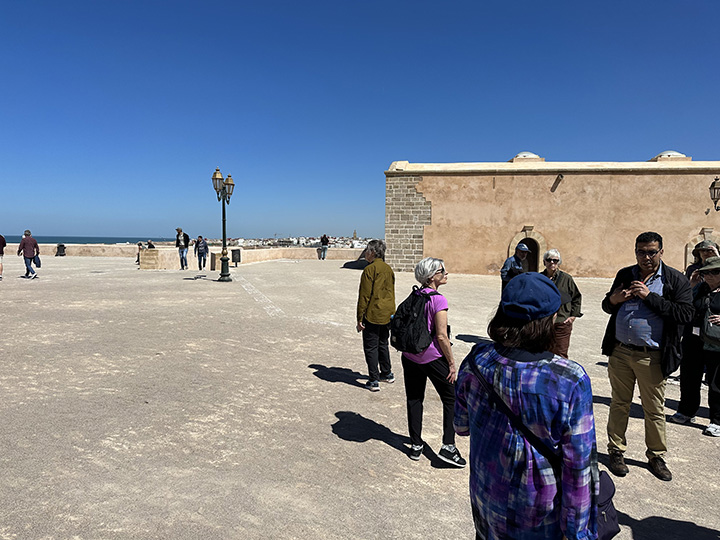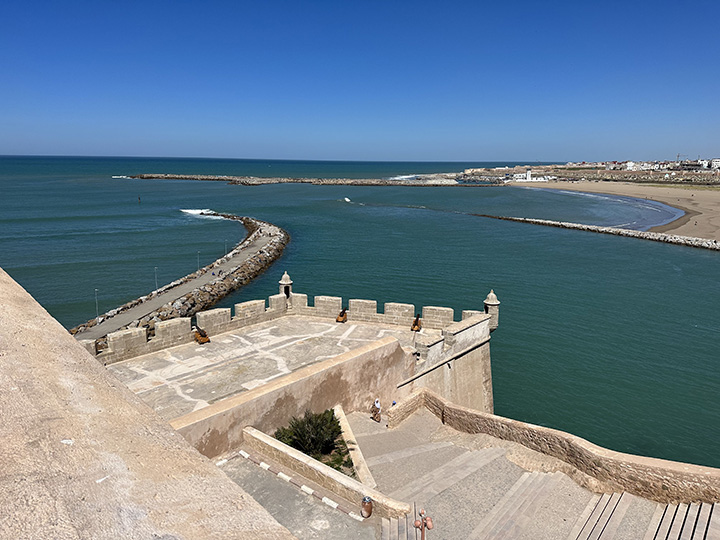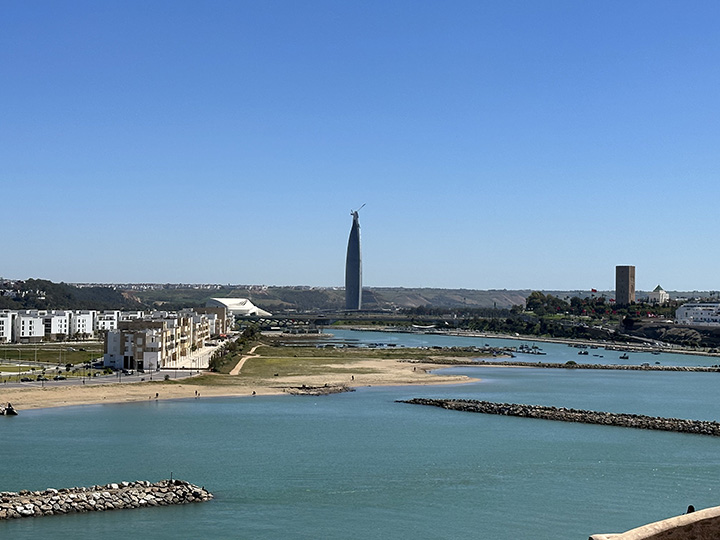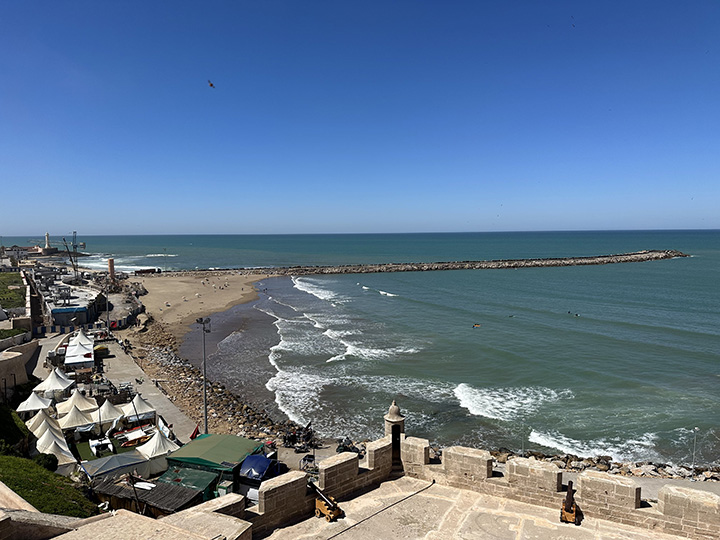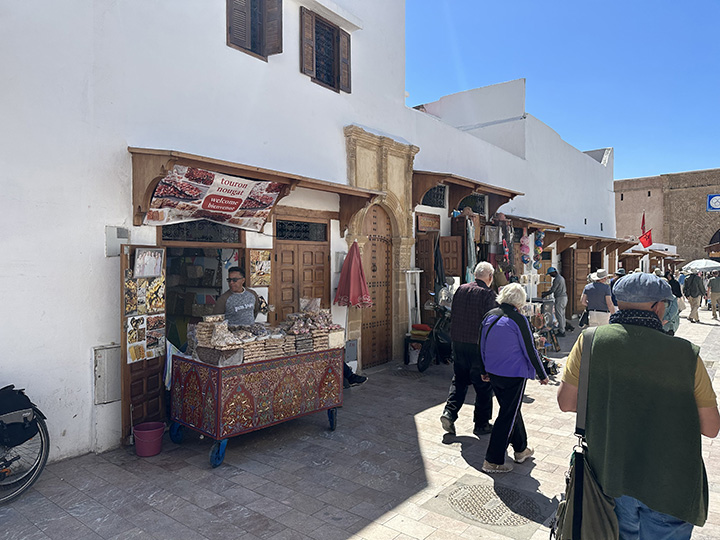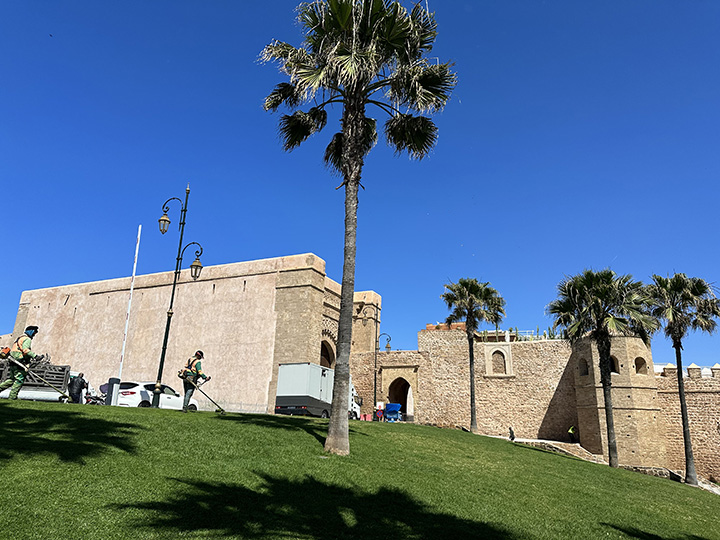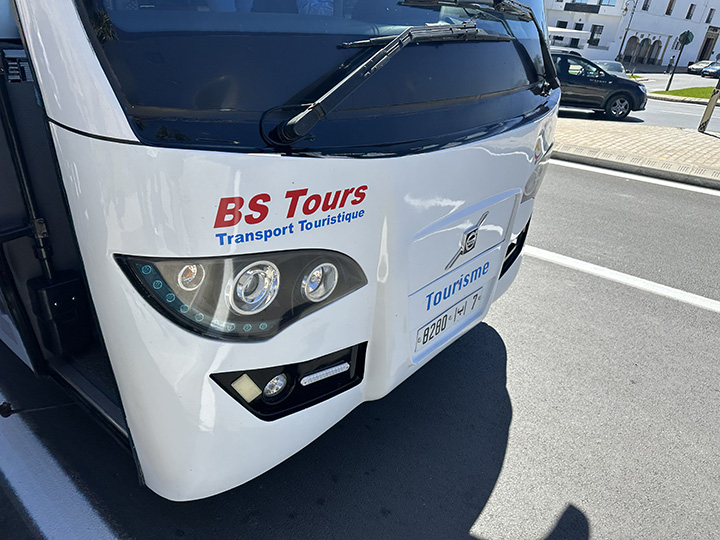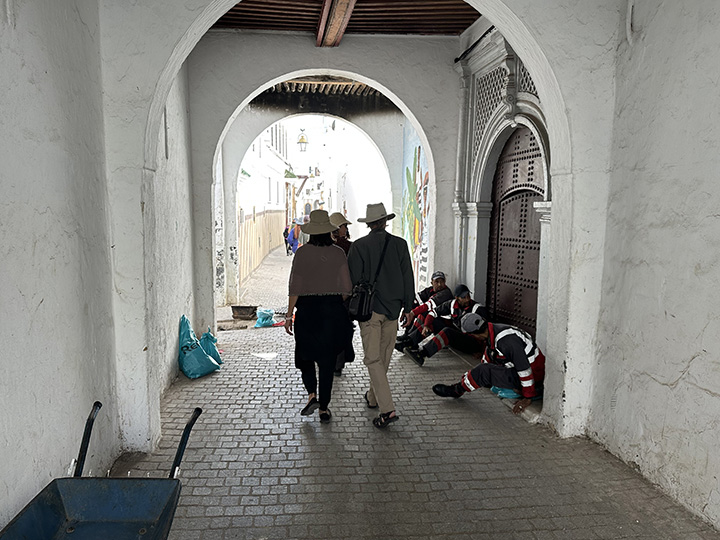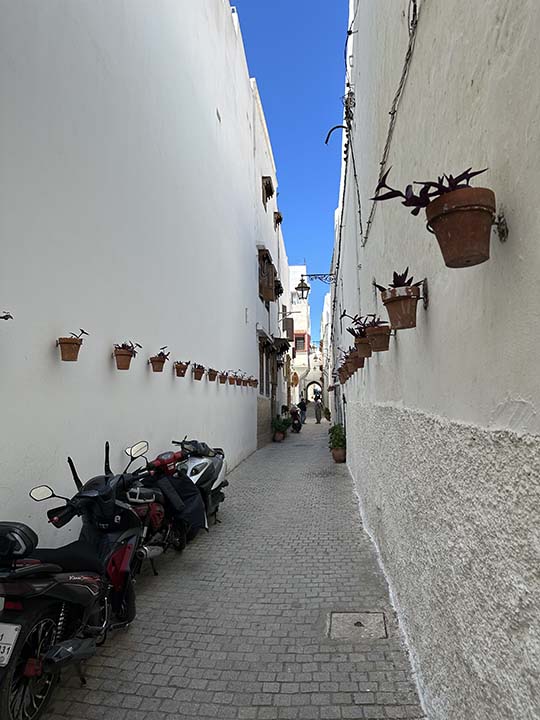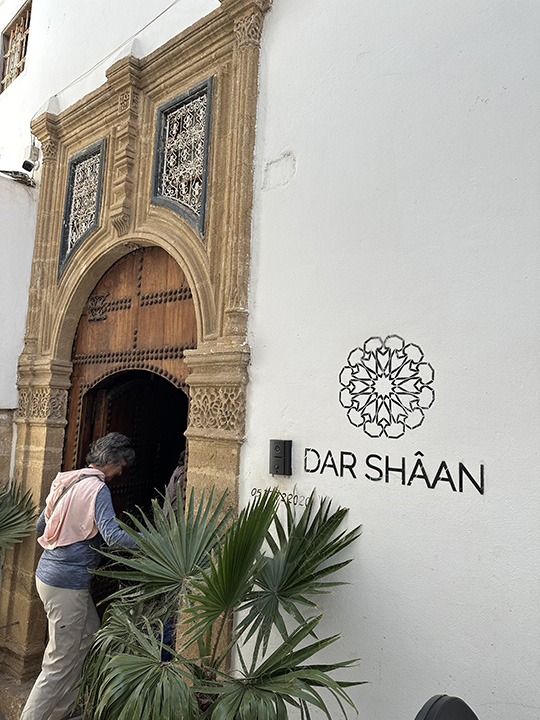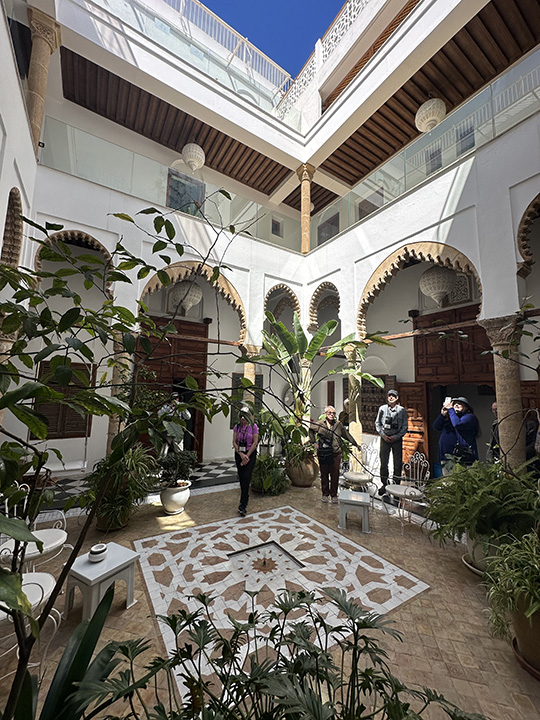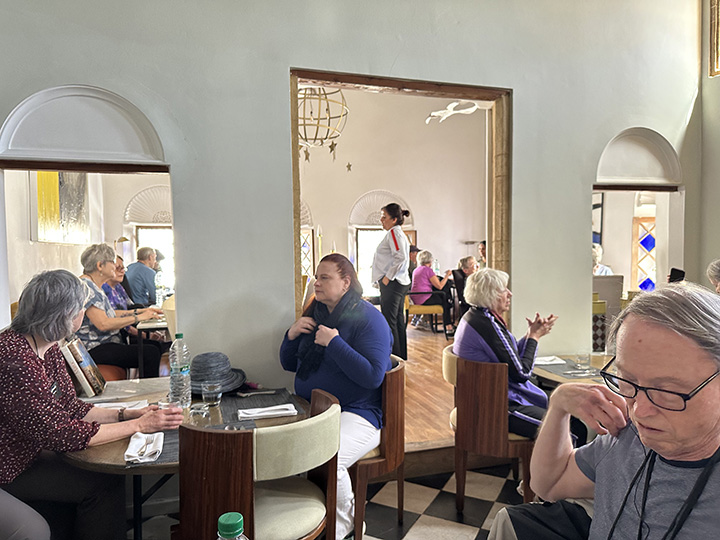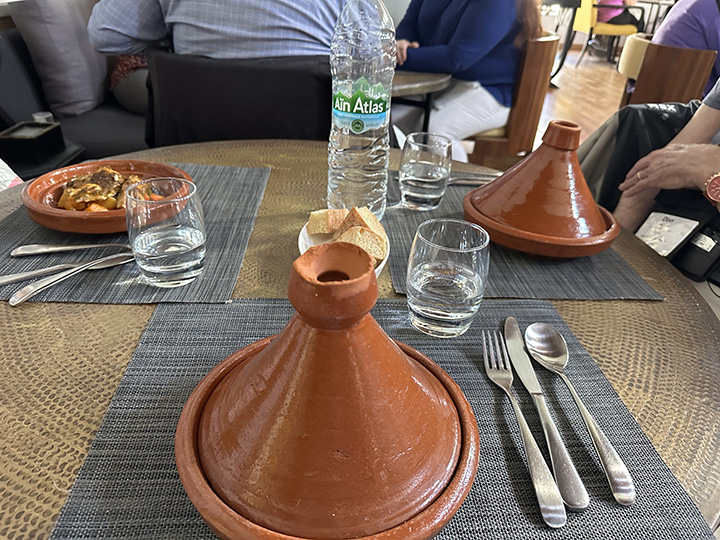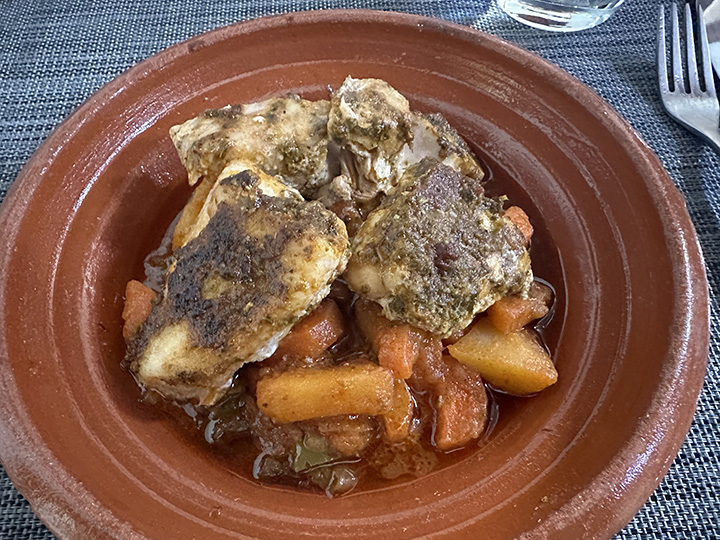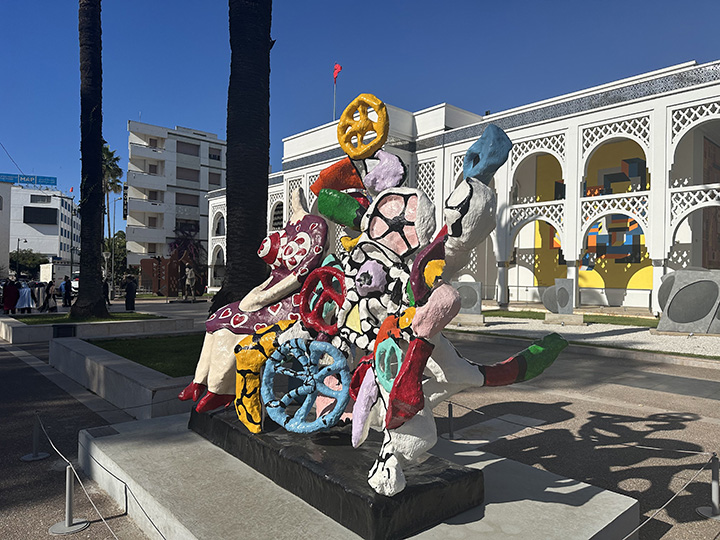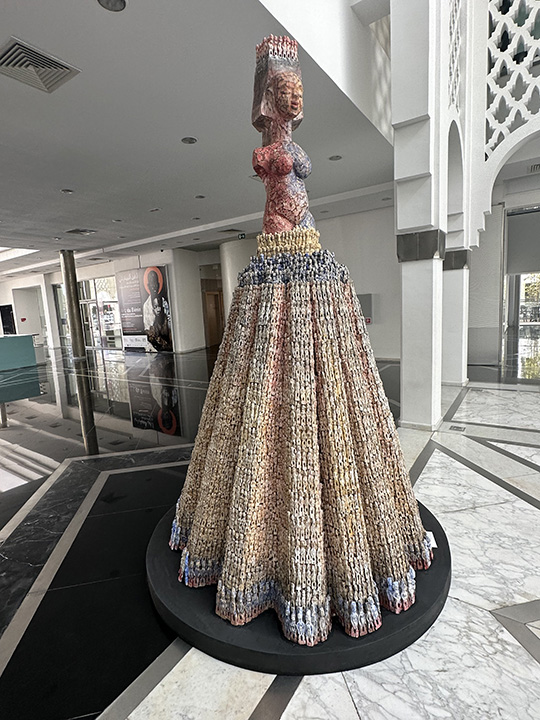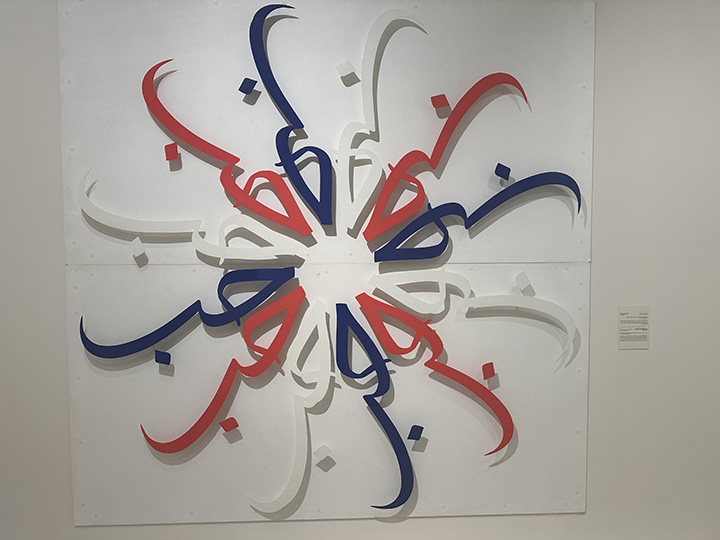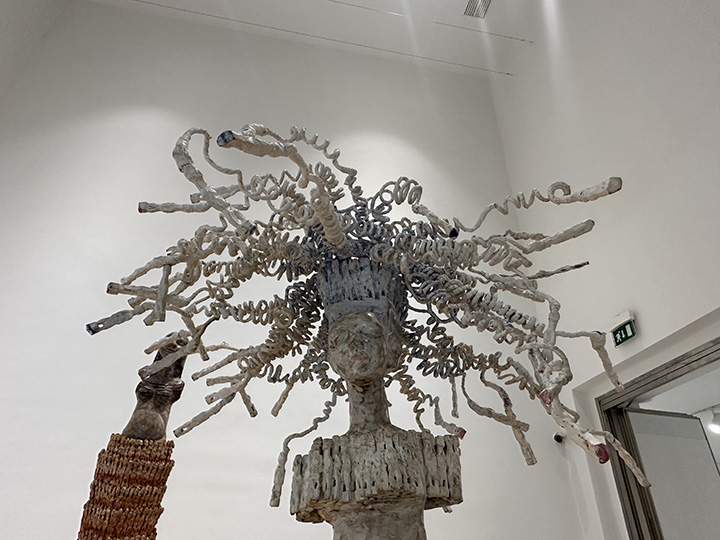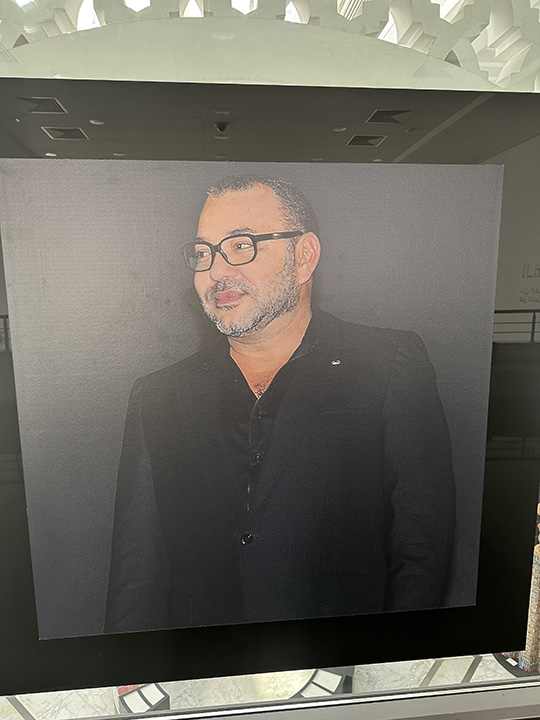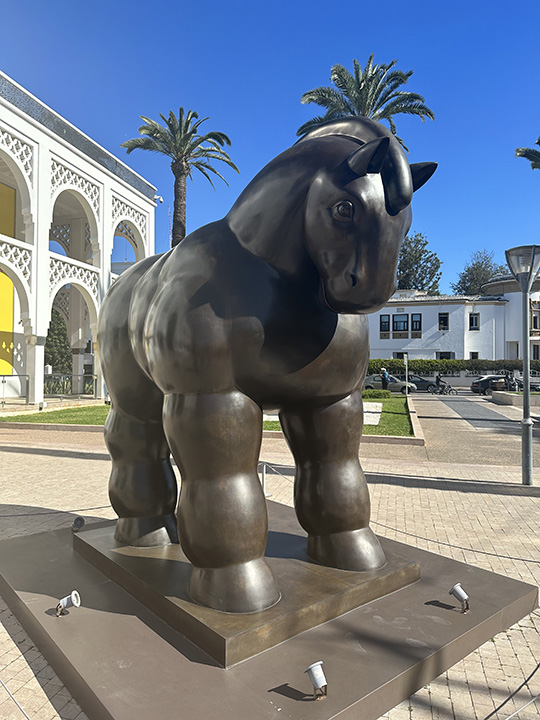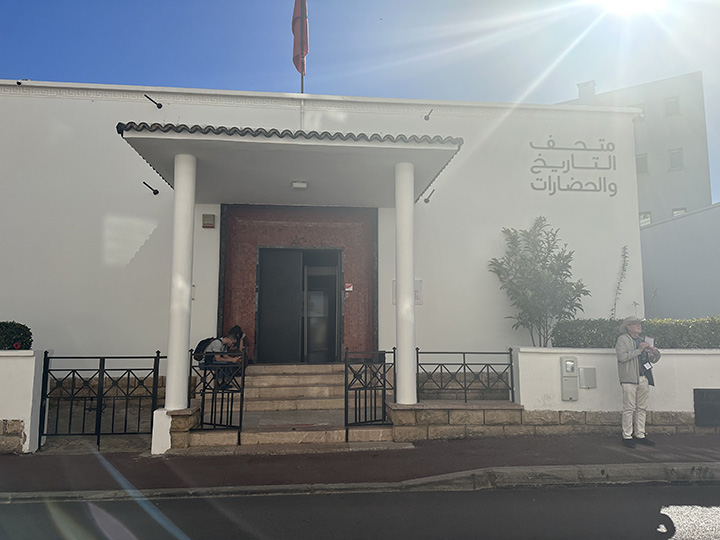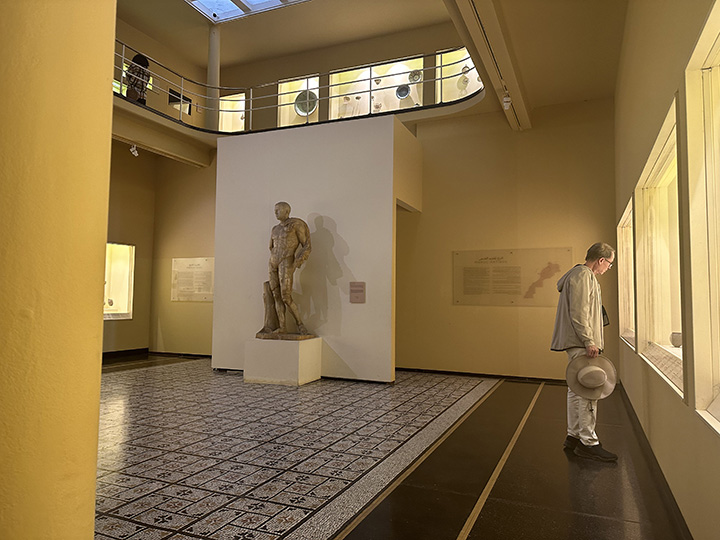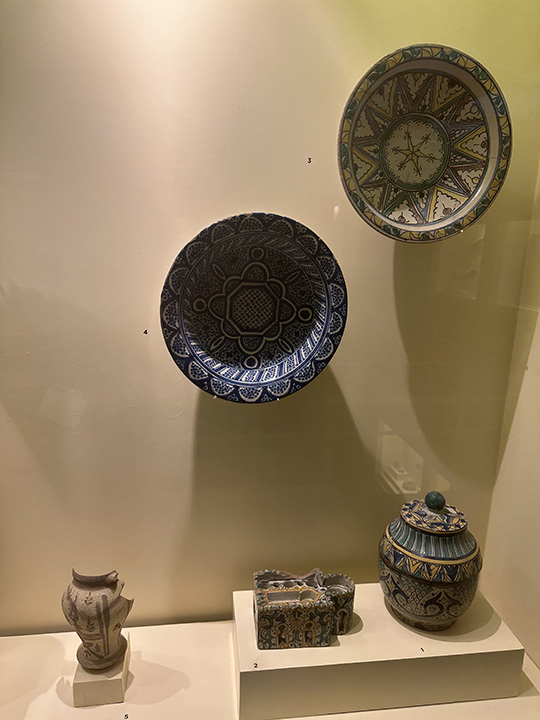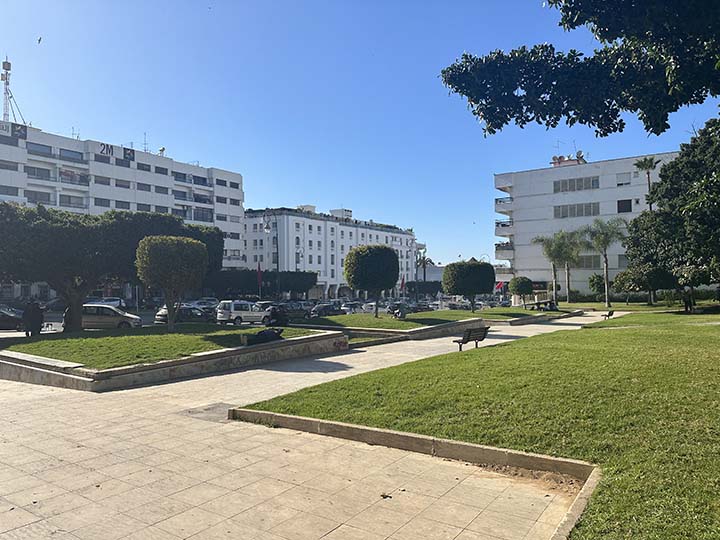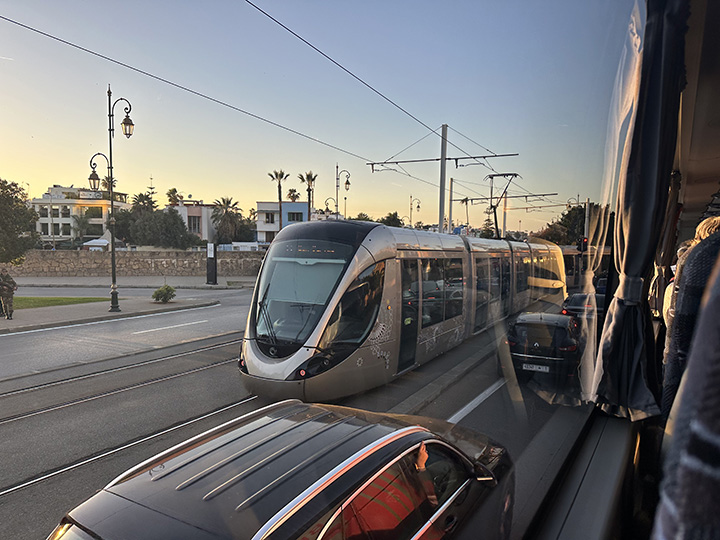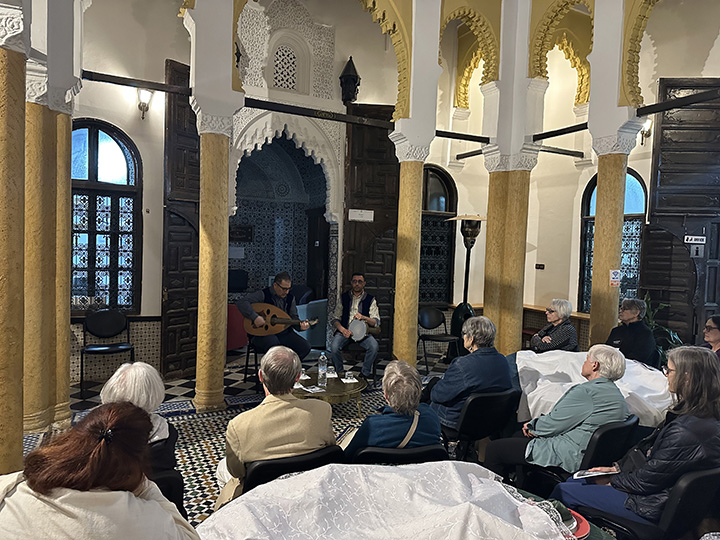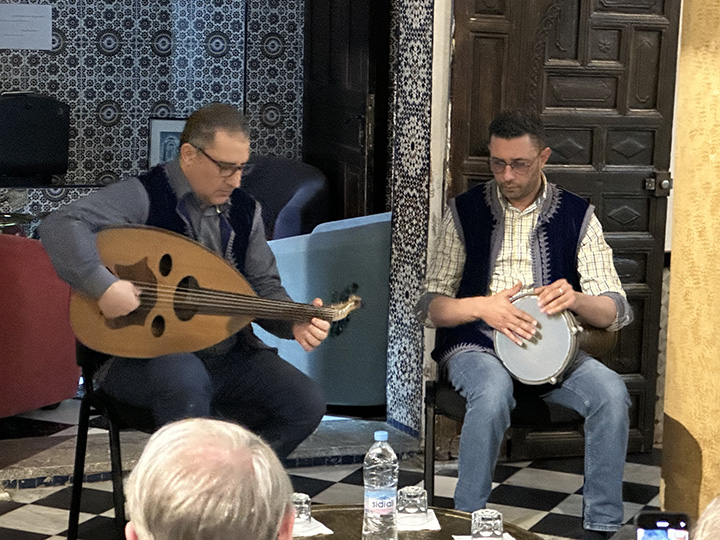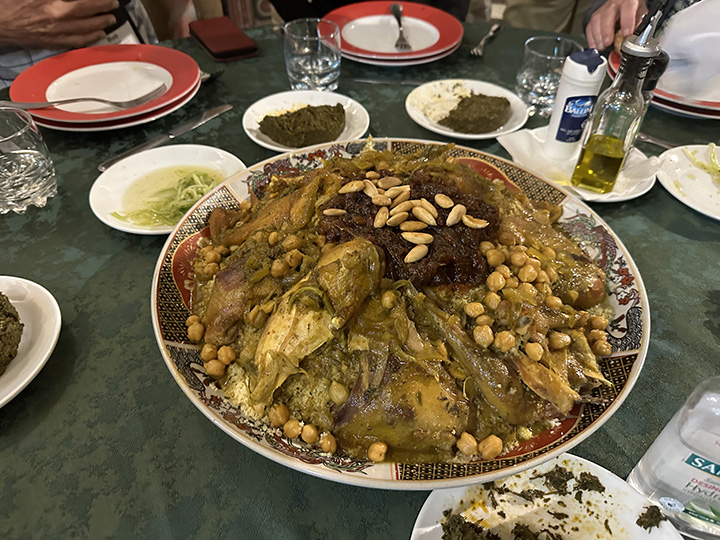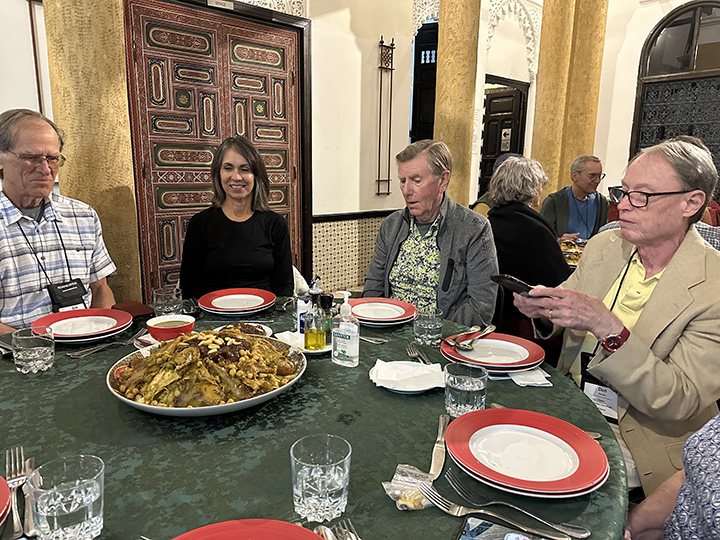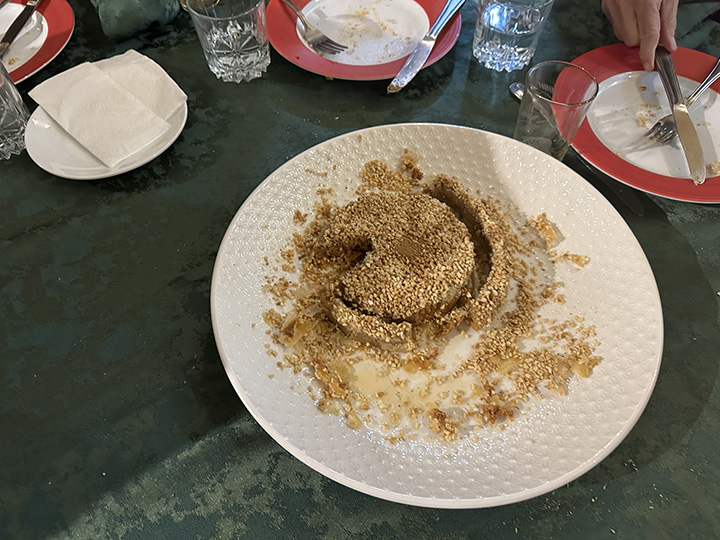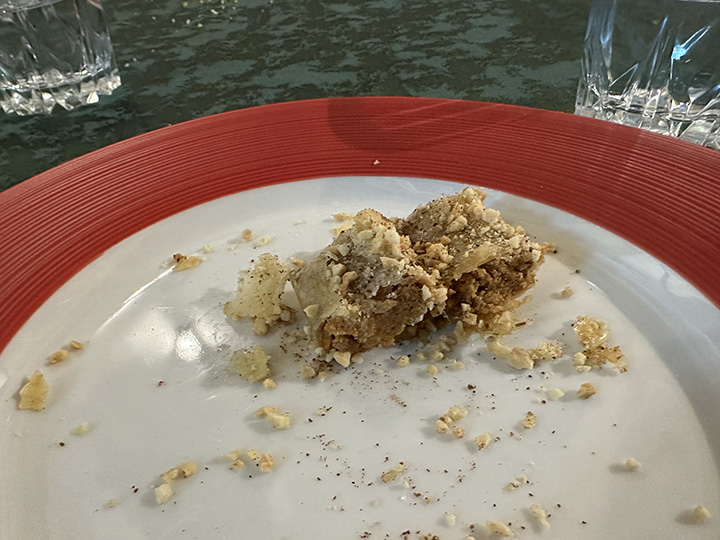|
The weather today has been spectacular. The temperature reached a high of almost 75° F and there is not a cloud in the sky. I am enjoying the tour very much, especially because I am learning about a part of the world and knew very little about. Did you know Morocco supported the United States in the Revolutionary War and that our oldest active treaty is with this country? I didn’t know that. Today we visited the grounds of Morocco‘s royal palace, saw a mausoleum and an unfinished mosque, visited two museums, and enjoyed a live performance of Andalusian music. When it was all over, I was pooped.
First stop was a mosque on the Moroccan Royal Palace grounds. We viewed it only from the outside, as non-Muslims are forbidden entry to all mosques in Morocco but one -- and we will see it on the final day of the trip in Casablanca.
That' the royal palace over there.
And that is the entrance to the palace itself. The Royal Palace or Dar al-Makhzen is the primary and official residence of the king of Morocco in Rabat. Its official name is El Mechouar Essaid, lit. 'Venue of Happiness'.
Nabil tells us all about it.
Hey gang, let's take a group photo!
Some pretty trees were just starting to blossom. They are called coral trees because of the color of the blossoms.
We passed the cucumber again.
I think foreign countries have more roundabouts than we do in the USA. The last time I was in England we rented a car and I drove and that's where I discovered I really hate driving in roundabouts, especially if I'm driving on the wrong side of the road. In Rabat they name the roundabouts, sometimes for American presidents. I think this one was John F. Kennedy. Another one was Abraham Lincoln.
That is the outside of a never completed mosque.
On the grounds of the incomplete mosque they have built a mausoleum that is so important horse mounted guards are required.
They are solemnly protecting the mausoleum and they really don't want tourists touching the horse.
The Mausoleum of Mohammed V is a mausoleum located across from the Hassan Tower in Rabat, Morocco. It contains the tombs of the Moroccan king Mohammed V and his two sons, late King Hassan II and Prince Abdallah.
Hassan Tower or Tour Hassan is the minaret of an incomplete mosque in Rabat, Morocco. It was commissioned by Abu Yusuf Yaqub al-Mansur, the third Caliph of the Almohad Caliphate, near the end of the 12th century. The tower was intended to be the largest minaret in the world, and the mosque, if completed, would have been the largest in the western Muslim world. When al-Mansur died in 1199, construction on the mosque stopped. The minaret was left standing at a height of 44 meters. The rest of the mosque was also left incomplete, with only the beginnings of several walls and 348 columns being constructed. The tower, along with the remains of the mosque and the modern Mausoleum of Mohammed V, forms an important historical and tourist complex in Rabat.
It’s a beautiful place with elaborate fountains that have no water because the country is in the middle of a drought
Though they were left incomplete when construction of the mosque stopped in 1199, the place did have walls. But they came tumbling down during the great Lisbon earthquake in 1755.
All that’s left are some crumbling walls with holes. We saw holes in walls like this all over Morocco. They provide ventilation to prevent the walls from deteriorating due to heat expansion during the torrid summer months. Don very wisely chose March for our trip -- the temperatures will be just about perfect throughout our stay.
There's a nice view from up here. That's the rival city of Sale across the river.
What there is of the incomplete minaret is still pretty spectacular.
There was going to be a very nice mosque here.
But frankly there's not much to see now.
Yep, that's Sale over there. As I mentioned, the cities criticize each other. According to Nabil, the people of Sale think the people of Rabat are snobbish. They seem pretty nice to me.
The Kasbah of the Udayas is a Kasbah (citadel) in Rabat, Morocco. It is located on a hill at the mouth of the Bou Regreg river, opposite Salé, and adjacent to the old medina of Rabat. It is listed, along with other sites in Rabat, as a UNESCO World Heritage site.
Site. Bill has always wanted to say this:
Now come viz me to ze Kasbah.
According to Nabil, it used to be a defensive fort, but now it is a residential area.
That’s the old fountain where people got their water before plumbing was invented.
Let's go exploring.
The streets are narrow.
And the doors are blue.
Very blue.
Lots of interesting doors around here.
Don is definitely interested.
See? No infidels allowed.
Nabil is pointing out a small door and asking us if we can guess why it is so small. The answer was that the owner of the house with the small door wanted people who came inside to bow first to indicate their submission to Allah.
Nancy thinks this door is the perfect size.
There's some interesting architecture in the Kasbah.
But the cats aren't particularly impressed.
Now we are stepping out onto a parapet that has a nice view of the city and the Atlantic ocean.
Nice view.
And a great location. From here you can see the giant cucumber, the fancy concert hall, and the incomplete minaret.
You can also see the Atlantic ocean. Nabil says if you go straight out there you’ll eventually come to Georgia. He says that Moroccans look out there and long to travel to America, the land of opportunity.
Time to leave the Kasbah and find some lunch.
Very interesting place.
Very interesting name for a tour company.
Lunch is down here somewhere.
The streets are still narrow but nicely decorated.
Here is where we will have lunch.
This is nice old riad has been turned into a restaurant.
Which is a good thing because the Road Scholars are hungry.
This pot is called a tagine. We will be seeing plenty of them in the coming days.
Inside the tagine was a serving of fish and carrots. It was ... fine.
After lunch we visited an art museum. The Mohammed VI Museum of Modern and Contemporary Art is a contemporary and modern art museum in Rabat, Morocco which opened in 2014. It is one of fourteen museums of the National Foundation of Museums of Morocco. The museum curates modern and contemporary Moroccan and international art. The MMVI is the first large scale museum built in Morocco since independence from France in 1956. It was the first Moroccan public museum to meet International Museography Standards. The museum houses the works of 200 Moroccan artists, including Hassan Hajjaj and Ahmed Yacoubi.
Some of the art was pretty.
Some of it was weird.
And some of it was just downright spooky.
At least the picture of the King looked like the King.
Fernando Botero Angulo (born 19 April 1932) is a Colombian figurative artist and sculptor, born in Medellín. His signature style, also known as "Boterismo", depicts people and figures in large, exaggerated volume, which can represent political criticism or humor, depending on the piece.
That was enough of that so we walked down the street to the Museum of History and Civilizations. It is an archaeological museum in Rabat, Morocco. Opened in 1932, it contains the most extensive collection of archaeological artifacts found in the country.
But it is not very big.
And there is seriously not a lot to see.
So we walked back to our hotel, which you can see in the center of the picture, and I took a little nap until it was time to take the bus back to the CCCL. Do you remember what that stands for?
There is some very nice public transportation in Rabat. But we stuck to riding our bus.
Upon arrival at the CCCL we were treated to a concert of traditional Andalusian music.
Have a listen.
These guys were good.
And now it's time to eat in style.
There is a big pile of unusually fine couscous under all that chicken and caramelized onions with honey and chickpeas and almonds. The dish is called Tfaya, and that's not a typo. Oh boy this was good.
After we got our pictures we dove in.
And this was dessert: mhancha. It is hard to tell in the picture but this is one long roll of almond paste stuffed into a tube and coiled up like a rope.
See how it's a rope?
Two little pieces of the rope. Oh boy oh boy oh boy this was good. A fine end to a busy, tiring, wonderful day.
On the way back to the hotel we passed a waterfront entertainment area. Those garish little buggies are for kids to ride.
|

